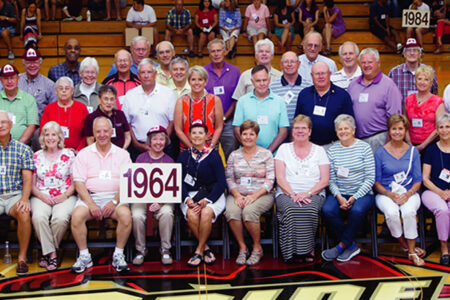The Ties That Bind
The branding process helps Springfield College become more deliberate about who we are and what we do.
SO WHAT’S THE STORY? YOUR STORY. About your Springfield College.
The memories, the now, and the stories yet to be shared … does your message speak all things Springfield College?“When the alumni say, ‘I really liked the people who were there. I really liked that time in my life, it helped me become a better person,’’’ Springfield College President Mary-Beth
A. Cooper, PhD, DM, says, “whatever that is for you … people generally feel good about being here. It’s their story.’’And even with great stories, impact often depends on delivery.
“We are refining our message in a way that helps us tell an authentic story about the institution and its people,’’ Cooper says. “We’re not hard to get, but it can be hard to articulate. All that Springfield College is … it’s hard to put that on a billboard.’’
Enter an 18-month long, institution-wide branding initiative driven by key objectives that include: raising awareness and visibility; strengthening its competitive position; increasing student recruitment; and improving advancement participation.
“We want to promote all of the many great attributes of Springfield College, attributes that set us apart from other colleges.”
“When I came here, people would ask me what Springfield College is like,’’ Cooper says. “People say it’s a special place. It has this great community that is unique. And it is all those things. But it won’t evoke the same words for you and for me, because we had different experiences here. But there will be common words, that we’ll both agree with.
“‘Spirit, mind, and body’ will always be a part of who we are. Service will always be part of who we are.’’
So what changes?
“We’re not changing anything, just enhancing,’’ says Executive Director of Marketing and Communications Steve Roulier. “We’re complementing our current arsenal of marketing tools.’’
Most tangible differences will be visual enhancements that include a logo, a branding image that includes ‘’the triangle’’ and embodies the initiative’s simple and strong objectives.
“It’s crisp and clean,’’ remarks Cooper. “The clarity that a simple logo brings has incredible impact. Think of the Duke ‘D’ or the Michigan maize ‘M.’ You know who they are, just by looking.
“The messages we’ve had in the past will still be included as we move forward. But this exercise, or initiative, was about providing a fresh look at Springfield College that represented us accurately. It represents who we are and who we’ve been.’’
The biggest challenge may come from off of the Alden Street campus, to and beyond its nine regional campuses and to the increasingly competitive field of higher education.
“In a perception survey that the College initiated three years ago, only one percent of respondents who lived outside of New England said that they’ve heard of Springfield College. One percent,” says Roulier.
And that battle continues.
“I had never heard much about Springfield College before I applied here,’’ says Briana Hill ’15. “We don’t want to just be another pamphlet. We want [prospective students] to be intrigued when they find us or look at our website. We want breadcrumbs … things that will lead people here.’’
Hill, a communication/sports journalism major from Somersworth, N.H., was a core marketing strategy advisory team member for the rebranding effort that also involved several members of the faculty and staff.
“In addition to that team, alumni were involved in the process from the beginning, with many participating in in-person interviews, phone conversations, or online surveys,” explains Roulier.
“We want to promote all of the many great attributes of Springfield College, attributes that set us apart from other colleges,” says Roulier. “This initiative is all about messaging. What are the messages that we want to communicate? Now that we are agreeing internally on those, we can have one unique voice in sharing a unified clear message.”
The collaborative rebranding effort reached an initial, public milestone in April, with the start of an incremental introduction of the new logo. The words “Springfield College,’’ in capital lettering, are centered, one word per line, over its traditional, inverted equilateral triangle.
Simple and clear.
“We want people to see it and say, ‘that’s Springfield College,’‘’ says Roulier. “Think of the University of Michigan. When you see that big ‘M,’ you know what it represents. You know what the university is good at.”
The rebranding initiative did reinforce one of the school’s indelible strengths.
“One of the great truths we’ve solidified is that the common and underlying theme for Springfield College is ‘service to others,’” Roulier says. “It’s our greatest strengths.”
Rebranding will only help Springfield College challenge an increasingly, ultra-competitive environment of higher education.
“It’s a very exciting time for Springfield College,’’ Springfield College Director of Sports Communications Brian Magoffin says. “We didn’t want to just be happy, to be satisfied with the status quo.
The Shape of a Mission
Leave it to a 19th-century renaissance man with a little pragmatism to develop a mission statement and embody it in the simplest of geometric shapes — the triangle.
And one that is relevant today, thriving as the single, most identifiable visual symbol of Springfield College.
The triangle was first introduced by Luther Halsey Gulick, the College’s first physical director.
“He was a genius and he knew he was a genius,” says Springfield College archivist Jeffrey Monseau.
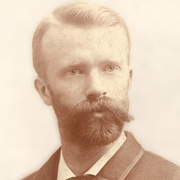
“He had great ideas about everything, and one of his quintessential ideas was that everything about man should be in balance, not just with spirituality or intelligence or physical. And it was about finding practical solutions to the world’s problems. And to this day, that’s what this school means,” says Monseau.
As the school’s 13th president since its founding in 1885, Mary-Beth A. Cooper, PhD, DM, understands the deep-rooted significance of the triangle as it relates to a current institution-wide branding initiative.
“Why the triangle? It represents spirit, mind, and body. So without saying it, it says so much more. No one would allow themselves to even imagine not having the triangle associated with Springfield College,’’ Cooper says.
Gulick, a faculty member at the School for Christian Workers (the first of five names of Springfield College), helped establish the triangle as a symbol that is still synonymous with the school. To him, the inverted, equilateral triangle represented the complete person. It was first adopted in 1891, when the school was known as the International YMCA Training School.
Past president Laurence L. Doggett wrote that “the symbol of the Triangle became the emblem of the Training School five years before it became emblem of the YMCA.’’
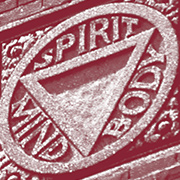
“The triangle was meant to be simple, like the Red Cross,’’ Monseau said. “It has stayed true since the 1880s, and today people immediately know this is Springfield College.’’
Its relevancy and meaning are as strong today as in 1894, when Gulick wrote “the triangle stands, not for body or mind or spirit, but, for the man as a whole.’’
Doggett wrote in The Man and his School that Gulick’s theory was “in line with the most advanced thought of the day … Expect to see this school become one of the influential centers of the country in regard to the philosophy of education.’’
The triangle has been most visible as part of the presidential seal, which through its evolution has always included a triangle.
Director of Sports Communications Brian Magoffin says, “When students start here and see the triangle and the ‘spirit, mind and body,’ not many will know it. But when they leave … not many students at other colleges know their mission statement, to be able to rattle it off like they can here.”
And not surprisingly, the current introduction of a new institution-wide logo features a triangle.
– Russ Held
Read Luther Gulick’s thoughts on “What the Triangle Means” at springfieldcollege.edu/trianglemeaning
Higher education is so competitive, so if someone is going to spend ‘X’ amount of money, we want to make sure that they are aware that we educate leaders in the fields of service, health, and wellness, in addition to knowing we are a world-class physical education school and athletic school. Springfield College is a place where many of the brightest students and leaders in many fields come to receive their education.’’
The project was driven by the work of senior staff members, a core strategy marketing advisory team, the president, and the board of trustees. Outside help came from Ologie, a Columbus, Ohio-based national marketing and branding agency, and volunteer consultants from Travelers International, Mount Holyoke College, and the Boston Bruins.
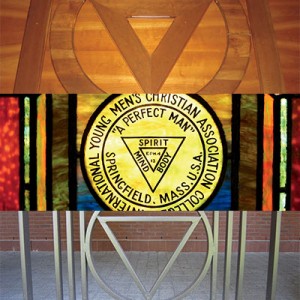
To date, solicitations of input have involved more than 700 people, among them current and prospective students, College leaders and Trustees, and members of the alumni, faculty, and staff bodies.
As detailed by the committee and Ologie, key deliverables include authentic and effective brand positioning, messaging to tell a compelling story about the institution, and comprehensive brand elements.
“I lived there and worked at Springfield College for four years. [Ologie] really understood our mission statement,’’ says Hill. “They understood the triangle, that Springfield College is the place that educates you spiritually, physically, and emotionally to become leaders in the world. We just need to do a better job promoting it to the outside world.’’
And not surprisingly, the triangle lives on.
“The triangle? Anyone we talked to about this … they said, ‘Don’t mess with the triangle.’’’ Cooper explains.
Cooper tells of a particular meeting with the College’s Board of Trustees, when an outside consultant initially “warned’’ that the triangle symbol may not survive the evolution of the branding initiative. “There are triangles everywhere, even on trash cans … no one could imagine not having the triangle be part of our logo,’’ says Cooper. “The triangle represents ‘spirit, mind, and body’ and, without saying it, it says that much more.’’
“When the students leave here, our holistic approach to education is understood, if not ingrained. The triangle is strongly tied to the College’s mission for our alumni.”
Self-awareness of this mission statement has helped set Springfield College apart.
“It has helped … not many students at other colleges know their mission statement, to be able to it rattle off like they can here,’’ Magoffin explains. “When the students leave here, our holistic approach to education is understood, if not ingrained. The triangle is strongly tied to the College’s mission for our alumni, so there was a strong effort to keep it.’’
Long overdue, the establishment and use of a logo literally puts Springfield College on the visual map.
“The College has not used an official logo, not for some time, at least, and not in the current, expected definition of a logo,’’ says Roulier. “We’ve used the College seal in a lot of our marketing, but most every college and university has a seal and they tend to look the same.’’
The seal has been around in various forms since it was adopted in 1891, and with the addition of a logo for the College’s marketing and recruiting purposes, Roulier says the College seal can now go back to its rightful place as the official business symbol of the College. “A seal typically is reserved for the highest official communication of an institution and used as a mark of guarantee,” he says. “While you’ll continue to see the seal at commencement, on diplomas, official College and especially presidential business, the logo will be used as a distinguishing mark for marketing and advertising.”
“We embrace our history here, and this process was made easier because of it,’’ Roulier says. “Think of what we’re about, who has been here and what has happened here. Martin Luther King Jr., JFK … the stories of our alumni like Tom Waddell, John Cena, Erin Pac, and numerous other women and men.”
“The College has not used an official logo, not for some time, at least, and not in the current, expected definition of a logo … we’ve used the College seal in a lot of our marketing, but most every college and university has a seal and they tend to look the same.”
A staple of the school’s 130 years of history is its place as “The Birthplace of Basketball,’’ a longtime tagline that doesn’t encompass all of or speak to what Springfield College is all about.
“It’s nice and who else can say that James Naismith was a professor here and he invented the game?’’ Roulier asks. “But ‘Birthplace of Basketball’ is confusing to other audiences. The Commonwealth of Massachusetts uses the slogan in its marketing. It even appears on a licenseplate. The City of Springfield also uses the slogan heavily in its promotional materials.
“What we’re doing now is branding Springfield College specifically. We’ll speak more often of our service to others, our leadership in the world, and how we educate our students to build a life, as well as earn a living.”
While the branding initiative is still in its infancy, school officials have said very little resistance, if any, was encountered.
“People are always wary, anytime you enhance something, especially if that thing has more than 125 years of history behind it,’’ comments Roulier.
As the branding has been woven into the fabric of Springfield College, so too has been its public introduction. By design, the initial release of the logo and messaging concepts in April came incrementally and without a splashy corporate-style unveiling.
Successful rebranding also will help keep one of the school’s greatest strengths — its athletics programs and reputation — in perspective.
“The perception here is that so many think of Springfield College as a ‘sports school’ and that if you don’t participate in sports, you won’t fit in here. That is so wrong,” emphasizes Roulier.
Hill concurs. “The second question people asked me about going here was ‘what sport do you play?’ not ‘what’s your major?’”
“From an athletics standpoint, our coaches want the best and brightest and now we can give prospective students a real, clear message,’’ Magoffin says. “People in the region know Springfield College. Branding will help us with our national exposure. Our volleyball coach recruits nationally, so there is visibility there. But we also want students in Southern California to know about our academic offerings.”

